
The giant panda, also known as panda bear or simply panda, is a bear native to south central China. It is easily recognized by the large, distinctive black patches around its eyes, over the ears, and across its round body. The name "giant panda" is sometimes used to distinguish it from the unrelated red panda. Though it belongs to the order Carnivora, the giant panda's diet is over 99% bamboo. Giant pandas in the wild will occasionally eat other grasses, wild tubers, or even meat in the form of birds, rodents, or carrion. In captivity, they may receive honey, eggs, fish, yams, shrub leaves, oranges, or bananas along with specially prepared food.

The bamboos are evergreen perennial flowering plants in the subfamily Bambusoideae of the grass family Poaceae. The word "bamboo" comes from the Kannada term bambu (ಬಂಬು), which was introduced to English through Indonesian and Malay.

Scaffolding, also called scaffold or staging, is a temporary structure used to support a work crew and materials to aid in the construction, maintenance and repair of buildings, bridges and all other man made structures. Scaffolds are widely used on site to get access to heights and areas that would be otherwise hard to get to. Unsafe scaffolding has the potential to result in death or serious injury. Scaffolding is also used in adapted forms for formwork and shoring, grandstand seating, concert stages, access/viewing towers, exhibition stands, ski ramps, half pipes and art projects.

The Bamboo Curtain was the Cold War political demarcation between the Communist states of East Asia, particularly the People's Republic of China, and the capitalist and non-Communist states of East, South and Southeast Asia. To the north/northwest lay Communist China, the Soviet Union, Vietnam, and others. To the south and east lay capitalist/non-Communist India, Japan, Indonesia, and others. In particular, following the Korean War, the Korean Demilitarized Zone became an important symbol of this Asian division.
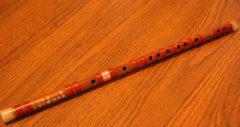
The dizi, is a Chinese transverse flute. It is also sometimes known as the di (笛) or héngdi (橫笛), and has varieties including the qǔdi (曲笛) and bāngdi (梆笛).

The Tale of the Bamboo Cutter is a 10th-century Japanese monogatari containing Japanese folklore. It is considered the oldest extant Japanese prose narrative although the oldest manuscript dates to 1592.

Wacom Co., Ltd. is a Japanese company headquartered in Kazo, Saitama, Japan, that specializes in graphics tablets and related products.
The Seven Sages of the Bamboo Grove were a group of Chinese scholars, writers, and musicians of the third century CE. Although the various individuals all existed, their interconnection is not entirely certain. Several of the seven were linked with the Qingtan school of Daoism as it existed in the state of Cao Wei.
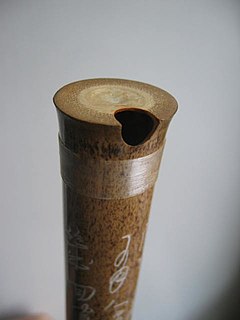
The xiao is a Chinese vertical end-blown flute. It is generally made of bamboo. It is also sometimes called dòngxiāo, dòng meaning "hole." An ancient name for the xiāo is shùzhúdí but the name xiāo in ancient times also included the side-blown bamboo flute, dizi.

The Las Piñas Bamboo Organ in St. Joseph Parish Church in Las Piñas City, Philippines, is a 19th-century church organ with unique organ pipes; Of its 1031 pipes 902 are made of bamboo. It was completed after 6 years of work in 1824 by Father Diego Cera, the builder of the town's stone church and its first resident Catholic parish priest.

A bamboo fly rod or a split cane rod is a fly fishing rod that is made from bamboo. The British generally use the term "split cane." In the U.S., most use the term "bamboo." The "heyday" of bamboo fly rod production and use was an approximately 75-year period from the 1870-s to the 1950s when fiberglass became the predominant material for fly rods. Nevertheless, bamboo fly rods made from skilled makers continue to be 'state-of-the-art' in performance and are cherished and revered by their owners.

Lemang is a traditional food made of glutinous rice, coconut milk and salt, cooked in a hollowed bamboo stick lined with banana leaves in order to prevent the rice from sticking to the bamboo. It is commonly found in maritime Southeast Asian countries, especially Brunei, Indonesia, Malaysia and Singapore. The Minahasan version of this dish is known as Nasi Jaha, which is cooked in the same method.
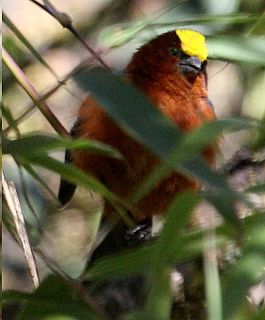
The plushcap is a species of bird in the family Thraupidae. It is the only member of its genus Catamblyrhynchus.
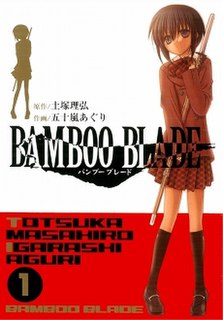
Bamboo Blade is a Japanese manga series written by Masahiro Totsuka and illustrated by Aguri Igarashi. It was serialized in Square Enix's Young Gangan magazine from December 3, 2004 to September 3, 2010. The series tells the story of Toraji Ishida, a luckless high school Kendo instructor, who is challenged by his former upperclassman, also a kendo instructor, to a competition between their female students. The bet inspires Toraji to gather and train a team of five girls, where he meets Tamaki Kawazoe, a gifted young female kendo practitioner.
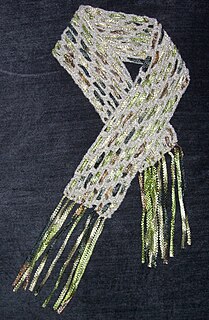
A bamboo textile is cloth, yarn, or clothing that is made from bamboo fibres. While historically used only for structural elements, such as bustles and the ribs of corsets, in recent years, different technologies have been developed that allow bamboo fibre to be used for a wide range of textile and fashion applications. Bamboo yarn can also be blended with other textile fibres such as hemp or spandex. Bamboo is an alternative to plastic, which is renewable and can be replenished at a fast rate.

Tylonycteris is a genus of bats within the Vespertilionidae or "vesper bat" family. The name translates as "padded bat", and refers to the presence of hairless fleshy pads on the hands and feet, which the bats use to help them grip onto bamboo.

Bamboo shoots or bamboo sprouts are the edible shoots of many bamboo species including Bambusa vulgaris and Phyllostachys edulis. They are used as vegetables in numerous Asian dishes and broths. They are sold in various processed shapes, and are available in fresh, dried, and canned versions.

Kralan or khao lam is a Southeast Asian rice dish made of sticky rice with red beans, sugar, grated coconut and coconut milk roasted in specially-prepared bamboo sections of different diameters and lengths. It can be prepared with white or dark purple varieties of glutinous rice. Sometimes described as a "cake", thick khao lam containers may have a filling of coconut custard in the center which is made from coconut cream, egg and sugar.In Thai, “kao” means glutinous rice and “lam” means the cooking process which involves roasting the contents in prepared bamboo sections. Kaolam has many advantages. For example, it can be consumed as food or as a dessert It is a cultural food and is an OTOP product. Moreover, Thai people present Kaolam to monks to make merit. Furthermore, it is gradually becoming a Thai tradition.
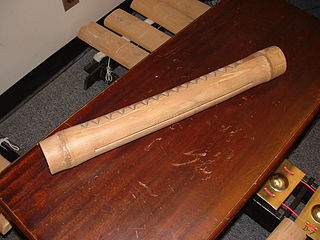
Bamboo's natural hollow form makes it an obvious choice for many musical instruments, most commonly flutes.

Kue putu or putu bambu is a traditional cylindrical-shaped and green-colored steamed cake. The cake is made of rice flour called suji and colored green with extract acquired from pandan leaf, filled with palm sugar, and steamed in bamboo tubes, hence its name, and served with grated coconut. This traditional bite-size snack is commonly found in Maritime Southeast Asia, particularly in Java, Indonesia, where the cake is called "putu bumbung". Kue putu can also be found in the Netherlands due to their colonial ties with Indonesia.




















